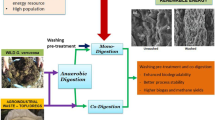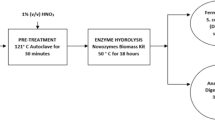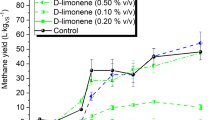Abstract
Sargassum muticum is a brown seaweed which is invasive to Europe and currently treated as waste. The use of S. muticum for biofuel production by anaerobic digestion (AD) is limited by low methane (CH4) yields. This study compares the biochemical methane potential (BMP) of S. muticum treated in three different approaches: aqueous methanol (70% MeOH) treated, washed, and untreated. Aqueous MeOH treatment of spring-harvested S. muticum was found to increase CH4 production potential by almost 50% relative to the untreated biomass. The MeOH treatment possibly extracts AD inhibitors which could be high-value compounds for use in the pharmaceutical industry, showing potential for the development of a biorefinery approach; ultimately exploiting this invasive seaweed species.
You have full access to this open access chapter, Download conference paper PDF
Similar content being viewed by others
Keywords
1 Introduction
Sargassum muticum is considered a menace as it is an invasive seaweed species to Europe [1]. Although this seaweed species has the potential to be exploited for its pharmacological and biomedical value, it is treated as ‘waste’ as there are no current utilisation methods. Methods to utilise this seaweed in a biorefinery approach could have positive economic and environmental implications.
Seaweed shows potential as a feedstock for biofuel production via methods such as anaerobic digestion (AD) that can handle wet biomass [1]. During AD, organic material is converted in an oxygen-free environment into CH4 and carbon dioxide in a series of degradation steps carried out by different groups of bacteria and Archaea. However, the use of S. muticum as a feedstock for AD is currently limited by its low CH4 yields [1]. This could partly be due to potential inhibitors of AD in seaweed; secondary metabolites extracted from Asparagopsis taxiformis showed inhibitory effects against the ruminal microbial population and CH4 production in the first 96 h [2]. The removal of other components of seaweed, such as polyphenols and salts, have also been associated with CH4 yield enhancements [3].
This study aims to remove potential inhibitors of AD from S. muticum using aqueous methanol (MeOH). To the authors’ knowledge, this is the first study to determine the biochemical methane potential (BMP) of aqueous MeOH treated S. muticum and subsequently, its prospective use as a feedstock for AD. The BMP of MeOH treated residues is also compared to washed seaweed, a pre-treatment method that enhances CH4 production rates from summer-harvested S. muticum [4].
2 Experimental Methods
2.1 Sample Preparation
S. muticum samples were collected in May (spring) from Broadstairs, UK (TR399675). Samples of S. muticum were rinsed with deionised water (dH2O) to remove sand and any residues from the seawater, stored at −18 ℃, and freeze-dried (FD) (−55 ℃, 48 h).
Three types of samples were prepared from spring-harvested S. muticum samples (Table 15.1). The MeOH treated residues (MTR) from three replicates were pooled and air-dried under the fume hood (24 h). For each replicate, the extracts from the sequential extraction were pooled and dried (Genevac™ Concentrator EZ-2). The wash solutions from the sequential washing were pooled and freeze-dried (−55 ℃, 48 h), herein referred to as washed extract. Extraction yields were measured gravimetrically.
2.2 Dry Weight and Ash Content
Residues and extracts were dried in a vacuum oven at 105 \(^\circ{\rm C} \) overnight to determine their dry weight (DW) [4]. Ash and volatile solids (VS) contents were determined according to [5].
2.3 Biochemical Methane Potential (BMP) Determination and Specific CH4 Yield Calculation
The inoculum was collected from an anaerobic digester treating paper-making waste at Smurfit Kappa Townsend Hook Paper Makers, Kent, United Kingdom. The inoculum was ‘degassed’ in a water bath (37 \(^\circ{\rm C} \), 7 days) to minimise its contribution to the CH4 yields during the BMP test [6], and then homogenised using a handheld blender (Philips™) before use.
The Automatic Methane Potential Test System II (AMPTS II) was used to measure CH4 production. Replicates were made containing 2 g VS content of each sample type in Table 15.1. The inoculum was added to make an inoculum-to-substrate ratio of 5 and made up with water to 400 g. Blanks with only inoculum and water were used to calculate the net CH4 production from S. muticum, removing the CH4 contribution by the inoculum. Reactors were mixed continuously (150 rpm) and incubated at 37 \(^\circ{\rm C} \). CH4 volumes were recorded daily over 28 days and corrected to water vapour content at 0 ℃, 101.325 kPa.
Specific CH4 yields were calculated by multiplying the CH4 potentials and the amount of residue remaining after the washing and extraction processes if 1 kg WW of S. muticum was treated according to Table 15.1.
2.4 Statistical Analysis
Excel (2016) was used for t-tests, and IBM SPSS version 25 was used for one-way and two-way ANOVA (with post-hoc analysis). Dependent variable: net cumulative CH4 yield. Independent variables: treatment (FD samples, washed residues, MTR), day (time during BMP test).
3 Results
3.1 Dry Weight and Ash Content of Extracts and Residues
The material removed by washing FD S. muticum (42.8% DW) was significantly higher than those extracted by 70% aqueous MeOH (35.3% DW) (t-test, p < 0.05). The washed residues had a higher VS content and a lower ash content compared to MTR, corresponding to the higher ash content in the washed extract compared to the MeOH extract (Table 15.2). MTR and washed residues have significantly lower ash content and higher VS content relative to the FD samples (one-way ANOVA, p < 0.05).
3.2 CH4 Production Profile and Specific CH4 Yield
Figure 15.1 shows the CH4 production profile of FD samples, washed residues and MTR during the BMP test. A significant interaction between days of incubation and the treatment on the net cumulative CH4 production was found (two-way ANOVA, p < 0.05). Post-hoc comparisons revealed that, except for day 2, the CH4 production profile of MTR was significantly different from those of FD samples and washed residues for the duration of the BMP test (p < 0.05). In contrast, the CH4 production profiles do not differ significantly between washed residues and FD samples (p > 0.05), except for days 1 and 2 when the mean net cumulative CH4 production by washed residues was significantly lower (up to 54.5 mL CH4 g−1 VS) than FD samples (p < 0.05). Ultimately, while the final CH4 potentials (after 28 days) of FD and washed residues were not significantly different (p > 0.05), those of the MTR’s were statistically higher than both the FD samples and washed residues (one-way ANOVA, p < 0.05).
Net cumulative CH4 production of FD samples (FD [n = 3]; green triangles), washed residues (Washed [n = 6]; orange rectangles) and MeOH treated residues (MTR [n = 4]; red circles) over the duration of the BMP test (28 days). Final CH4 potentials (after 28 days) are shown in italics in their respective colours. Error bars represent standard deviations
The specific CH4 yield produced by MTR is statistically higher than the FD samples by 12.6% (t-test, p < 0.05) (Table 15.3). Comparatively, washing reduces the specific CH4 yield by 28.3% relative to the FD samples; mean yields were statistically different (t-test; p < 0.05).
4 Discussion
Washing FD S. muticum removed 7.5% more compounds than 70% aqueous MeOH. This is partly attributed to the higher ash content removed by water, which may be due to its higher solubility in water compared to MeOH. Higher extraction yields by water compared to alcoholic solvents are also found in the literature [7, 8]. The compounds removed by water had negative implications for AD of spring S. muticum. Despite enhanced VS content of 10.8% relative to the FD samples, washed residues still have lower specific CH4 yields (3.6 L CH4 kg−1 WW) and statistically similar CH4 potentials to FD samples.
MTR showed higher VS content relative to FD samples, but lower VS content relative to washed residues. MTR produced 49.8% and 34.4% higher CH4 potential relative to the FD and washed residues, respectively. The highest CH4 production potential achieved by MTR could, therefore, be related to the removal of potential inhibitors of AD from S. muticum. MeOH extracts of Sargassum spp. showed antibacterial activity against Bacillus subtilis, with up to half the inhibitory potential of tetracycline, a potent antibiotic with anti-methanogenic activity [9, 10].
Other potential inhibitory compounds of AD include polyphenolic compounds and fatty acids [11]. However, polyphenolic and lipid content of the three sample types showed no correlation to the CH4 potential (data not shown). Repeats of this experiment showed lower CH4 potentials from MTR, but are nevertheless higher than FD samples. Higher CH4 potentials in this experiment could be due to incomplete removal of aqueous MeOH. Further analysis of the antimicrobial potential and identification of compounds present in the aqueous MeOH extracts are needed to clarify their inhibitory potentials. The identification of compounds with a pharmacological or biomedical value may also allow for the development of a biorefinery approach.
5 Conclusion
Treating spring S. muticum with aqueous MeOH prior to AD can be an effective method to enhance CH4 production, making it a more suitable feedstock compared to untreated S. muticum. This pre-treatment method shows potential in a biorefinery approach to ultimately exploit this invasive seaweed species when potential uses of compounds extracted by MeOH are identified.
References
J.J. Milledge, P.J. Harvey, Ensilage and anaerobic digestion of Sargassum muticum. J. Appl. Phycol. 28, 3021–3030 (2016)
B.M. Roque, C.G. Brooke, J. Ladau, T. Polley, L.J. Marsh, N. Najafi, P. Pandey, L. Singh, R. Kinley, J.K. Salwen, E. Eloe-Fadrosh, E. Kebreab, M. Hess, Effect of the macroalgae Asparagopsis taxiformis on methane production and rumen microbiome assemblage. Anim. Microbiome 1, 3 (2019)
S. Maneein, J.J. Milledge, B.V. Nielsen, P.J. Harvey, A review of seaweed pre-treatment methods for enhanced biofuel production by anaerobic digestion or fermentation. Fermentation 4, 100 (2018)
S. Maneein, J.J. Milledge, P.J. Harvey, B.V. Nielsen, Methane production from Sargassum muticum: effects of seasonality and of freshwater washes. Energy. Built. Environ. (In Press)
BSI, Solid biofuels-Determination of ash content. BS EN 147752009 (2009)
I. Angelidaki, W. Sanders, Assessment of the anaerobic biodegradability of macropollutants. Rev. Environ. Sci. Bio/Technol. 3, 117–129 (2004)
S. Cho, S. Kang, J. Cho, A. Kim, S. Park, Y.-K. Hong, D.-H. Ahn, The antioxidant properties of brown seaweed (Sargassum siliquastrum) extracts. J. Med. Food 10, 479–485 (2007)
I. Jerez-Martel, S. García-Poza, G. Rodríguez-Martel, M. Rico, C. Afonso-Olivares, J. Luis Gómez-Pinchetti, Phenolic profile and antioxidant activity of crude extracts from microalgae and cyanobacteria strains. J. Food Qual. 2017(2017). Article ID: 2924508
I. Jaswir, A.H. Tawakalit Tope, R.A. Raus, H. Ademola Monsur, N. Ramli, Study on anti-bacterial potentials of some Malaysian brown seaweeds. Food Hydrocoll. 42, 275–279 (2014)
J.L. Sanz, N. Rodríguez, R. Amils, The action of antibiotics on the anaerobic digestion process. Appl. Microbiol. Biotechnol. 46, 587–592 (1996)
M. Czatzkowska, M. Harnisz, Inhibitors of the methane fermentation process with particular emphasis on the microbiological aspect: a review. Energy Sci. Eng. 8, 1880–1897 (2020)
Acknowledgements
The authors acknowledge the financial support of the University of Greenwich and the DTA.
Author information
Authors and Affiliations
Corresponding author
Editor information
Editors and Affiliations
Rights and permissions
Open Access This chapter is licensed under the terms of the Creative Commons Attribution 4.0 International License (http://creativecommons.org/licenses/by/4.0/), which permits use, sharing, adaptation, distribution and reproduction in any medium or format, as long as you give appropriate credit to the original author(s) and the source, provide a link to the Creative Commons license and indicate if changes were made.
The images or other third party material in this chapter are included in the chapter's Creative Commons license, unless indicated otherwise in a credit line to the material. If material is not included in the chapter's Creative Commons license and your intended use is not permitted by statutory regulation or exceeds the permitted use, you will need to obtain permission directly from the copyright holder.
Copyright information
© 2021 The Author(s)
About this paper
Cite this paper
Maneein, S., Milledge, J.J., Nielsen, B.V. (2021). Enhancing Methane Production from Spring-Harvested Sargassum muticum. In: Mporas, I., Kourtessis, P., Al-Habaibeh, A., Asthana, A., Vukovic, V., Senior, J. (eds) Energy and Sustainable Futures. Springer Proceedings in Energy. Springer, Cham. https://doi.org/10.1007/978-3-030-63916-7_15
Download citation
DOI: https://doi.org/10.1007/978-3-030-63916-7_15
Published:
Publisher Name: Springer, Cham
Print ISBN: 978-3-030-63915-0
Online ISBN: 978-3-030-63916-7
eBook Packages: EnergyEnergy (R0)





